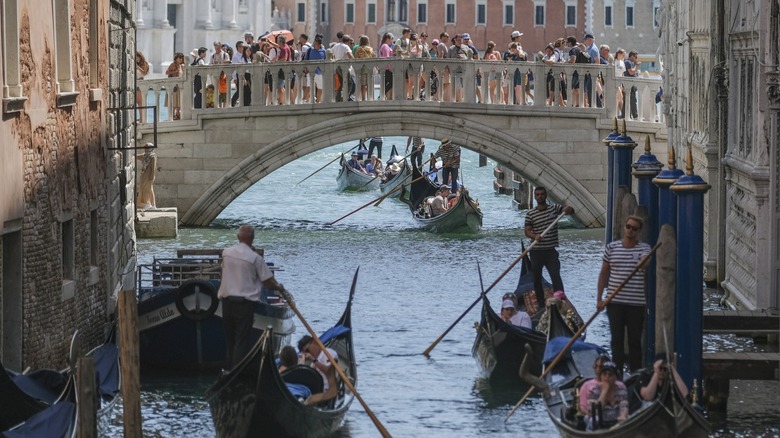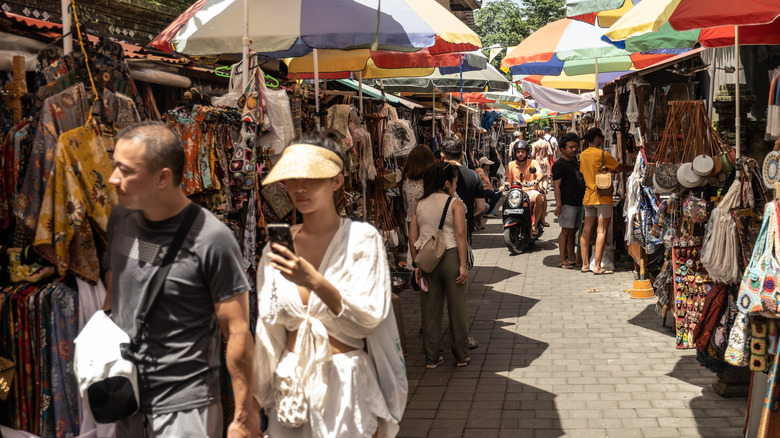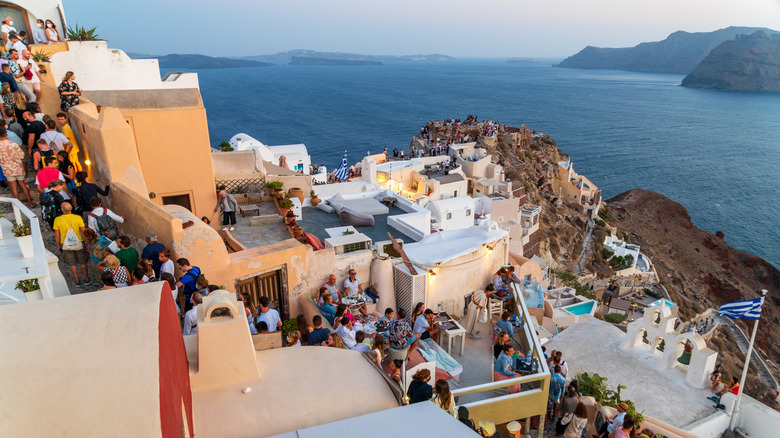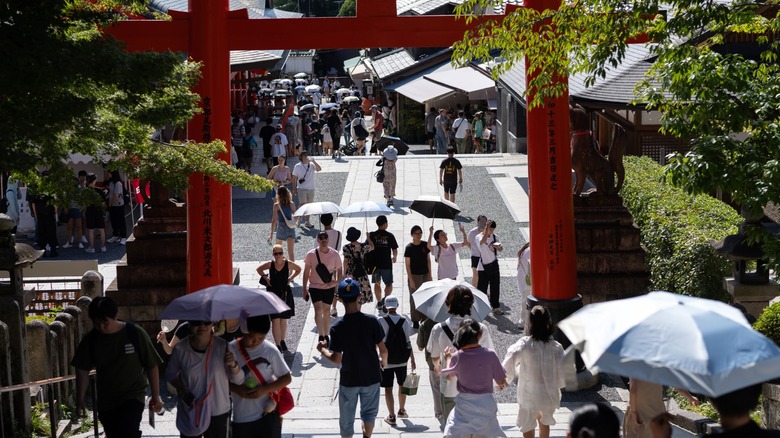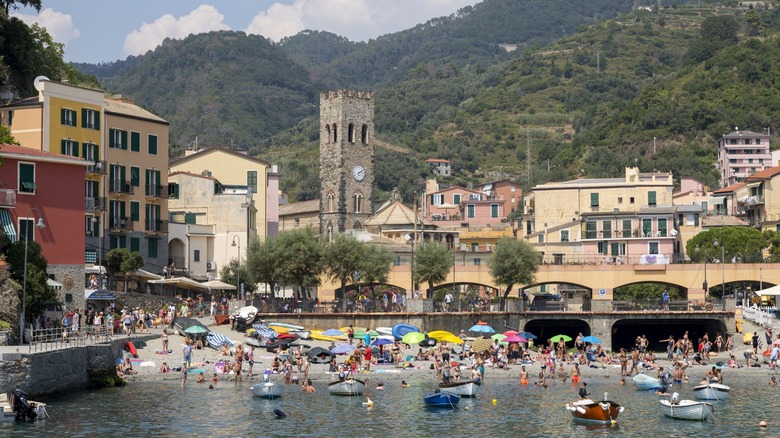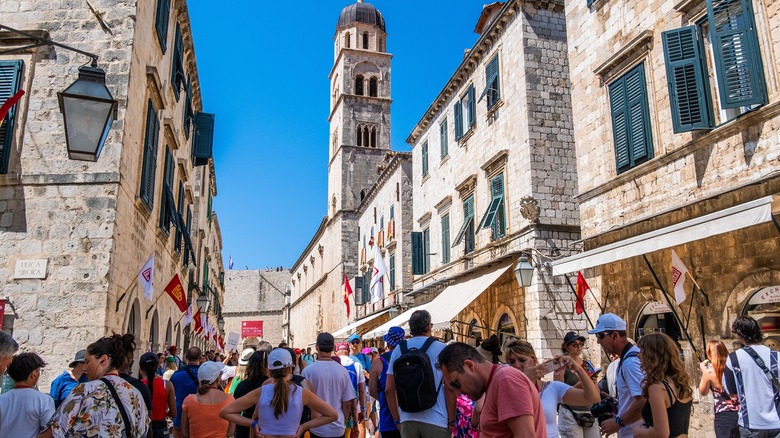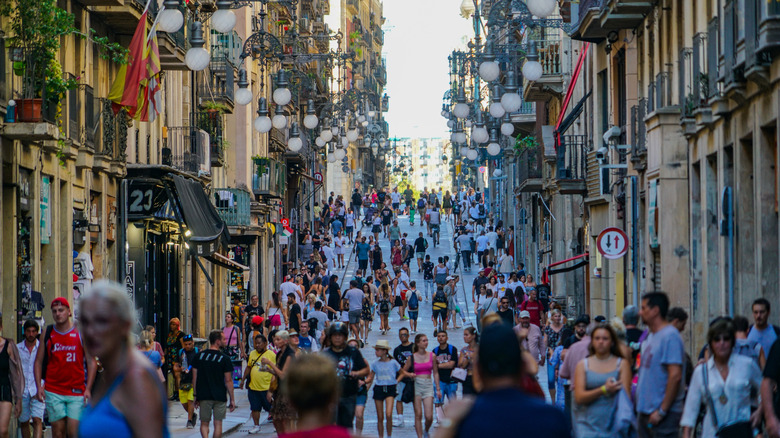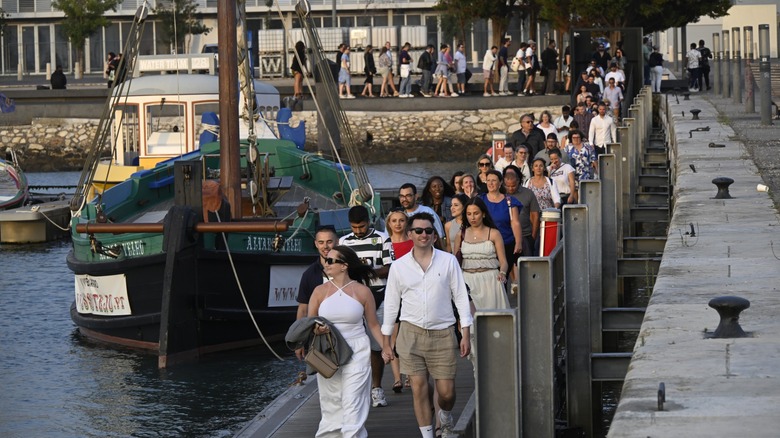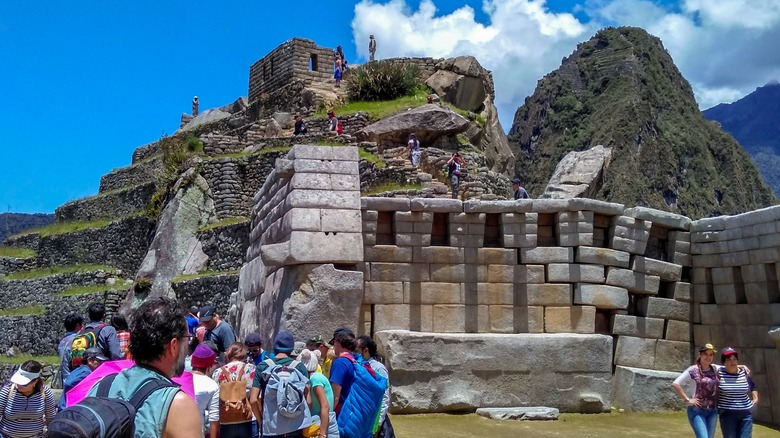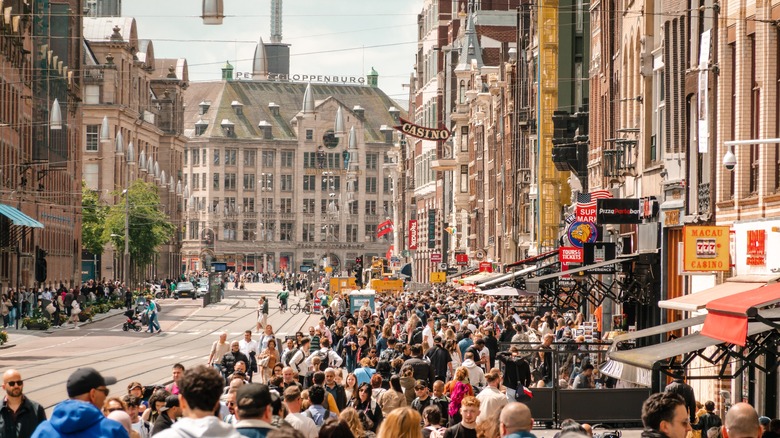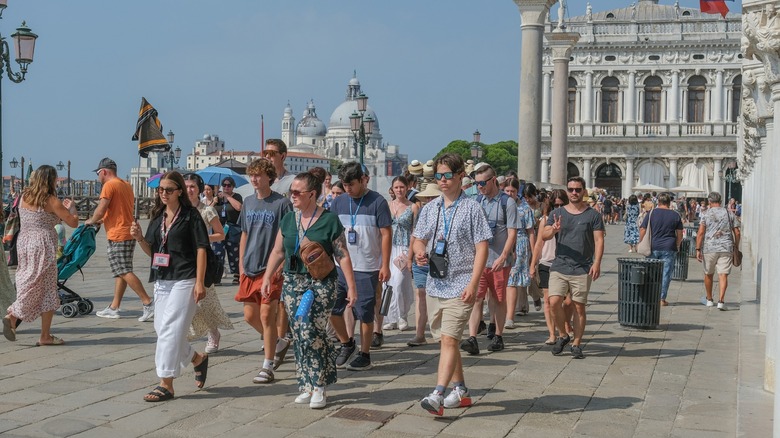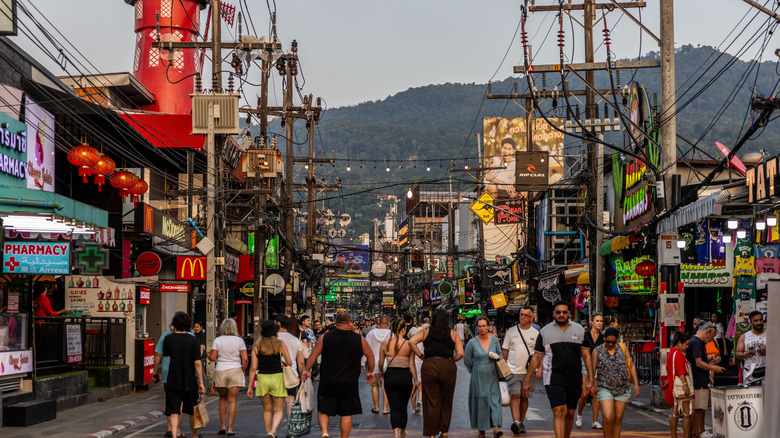The 13 Most Beautiful Destinations In The World Sadly Ruined By Overtourism
The world is wonderfully vast, but there are some destinations that, by virtue of the (often justified) hype, enjoy more popularity than others. When the goal is to party, travelers flock to the Southeast Asian islands of Bali and Phuket. When the dream is to stand in the exact spots where "Game of Thrones" was filmed, Dubrovnik, Croatia, is the place to be. And the dreamy postcard destinations of Venice, Italy, never get old for Instagram tourists searching the perfect shot. These travel routes, though formulaic, are rooted in the irrefutable beauty of these destinations people never tire of visiting. They deserve the attention they get.
The issue is, these destinations are unfortunately getting more attention than they can handle. Travel hotspots around the world are feeling the brunt of overtourism and the myriad complications it creates for local infrastructure — choked roads, water shortages, public nuisances, and even the physical deterioration of UNESCO World Heritage sites. With revenge tourism triggering a boom in international travel in the post-pandemic years, countries that are home to world-famous destinations are trying to find a sustainable middle ground that can create value for both the local economy and visiting tourists. Here are 13 beautiful destinations ruined by overtourism and how countries are trying to fix it.
Bali, Indonesia
Thanks to the mass mythologizing of Bali's party culture, many are visiting this Indonesian island with a fervor. While this shared global desire continues to breathe life into the tropical island's popularity, it has resulted in Bali commercializing at a pace faster than it can handle. From luxurious villas to happening beach clubs, the rapid development of hot spots tourists associate with a Balinese holiday have proved detrimental to the island, whose officials moved to halt the indiscriminate construction of such structures in 2024.
Apart from the usual side-effects of overtourism — which threaten the quality of life for locals and accelerate issues of traffic, pollution, and crime — Bali grapples with a unique set of tourism problems related to disorderly visitors. In fact, the situation got so out of hand that in 2023, tourists were handed guides at the airport that advised them about appropriate behavior and protocols to abide by once they were out and about on the island. "We don't want to see paddy fields become a villa or become a ... club. For us, quality is more important than numbers," tourism minister Luhut Pandjaitan said in 2024, explaining Bali's efforts to control tourism (via Reuters).
Santorini, Greece
It didn't take long for Santorini to become a mainstream travel destination once photos of its surreal blue-hued landscapes made it to social media. The charming Greek island in the south Aegean deserves all the hype it gets — a fact that has ironically become its biggest stumbling block as it draws tourists in excess. With 3.4 million tourists projected to visit in 2024, Santorini's mayor Nikos Zorzos highlighted the issue of overtourism that burdens the whitewashed island. "If you destroy the landscape, one as rich as ours, you destroy the very reason people come here in the first place," he told The Guardian.
Santorini is overrun not just with people clamoring to get picture-perfect snaps on Greece's "Instagram island," but also by hospitality industry stakeholders churning out hotels and experiences to meet the burgeoning demand. While the island is helping to bring in billions for the country, overtourism has made life difficult for Santorini locals, who have reportedly appealed for limits on the influx of travelers. The government has proposed the imposition of a €20 cruise tax for ships stopping at popular islands like Santorini and Mykonos.
Kyoto, Japan
When the first signs of overtourism began showing up in Japan's once-capital of Kyoto, country officials acted quickly to devise ways to curb the overflow of tourists. One key issue was the excess of non-residents using the city's local transportation system, which made daily commutes difficult for the people who actually lived there.
In response to locals' exasperation over the disruption of regular routines, authorities in Kyoto introduced one-day passes that would allow people access both buses and subways, in a bid to stave off the pressure on overcrowded buses, The Japan Times reported. Price points for certain amenities, such as parking fees, have also seen an upward hike in some tourist hotspots, while officials continue to discuss increasing tourist taxes to control overcrowding.
Some of Kyoto's other measures against overtourism have been more assertive — such as the barricading of certain streets in the historic neighborhood of Gion, which is one of the city's most popular spots and was beginning to be overwhelmed by troublemaking tourists harassing traditional geisha performers.
Boracay, Philippines
The coastal paradise of Boracay was once a hidden gem among Filipino locals. Eventually, however, the secret got out and it was crowned one of the most beautiful islands in the world by top travel magazines. As soon as news of its unparalleled beauty went mainstream, Boracay's natural landscape rapidly deteriorated under overtourism. The environmental damage became so dire that in 2018, Philippines President Rodrigo Duterte called for a shutdown of the island in a bid to reverse its growing reputation as a "cesspool," according to CNN. A cleanup of Boracay ensued, during which the government regulated everything from hotel construction to waste management, and the island gradually reopened to tourists six months later.
The number of tourists visiting Boracay had been approaching 2 million at the time. Years later, the tourist numbers are not too different. During the rise and fall of visitors during the COVID-19 years, the rehabilitation of Boracay was praised by some on the Philippine island. "There was a free-for-all to get as many on the island without regard to impact and now there is control," a spokesperson for one of the island's major hospitality chains told The New York Times. Boracay's daily tourist cap has been set at around 6,000 since its reopening in 2018, with authorities now reportedly ready to expand that limit.
Cinque Terre, Italy
Cinque Terre, an area in Italy home to several historic seaside towns, is so swamped with visitors year after year that it has sadly been reduced to little more than one of Italy's many overrated tourist traps. A record 4 million tourists visited Cinque Terre in 2023. Today, the collection of cliff-hanging villages — with colorblocked houses, scraggy coastline, and turquoise waters — still reigns supreme as a travel bucket-list item and is among Italy's most picturesque marvels. That charm, however, is seriously threatened by swathes of tourists clogging up some of the region's most popular locales, like Vernazza.
"The main challenge is how to distribute tourism across the area, and we need to do it quickly without giving the impression that we are anti-tourist, as for us, tourism is fundamental," a local mayor in Cinque Terre told The Guardian. Control measures in the area have ranged from conventional to out-of-the-box: while limits on the number of ferries allowed on the coast were hardly surprising, authorities got a little more creative in 2019 and imposed a fine on the wearing of inappropriate footwear on challenging cliff trails. Then in 2024, when Cinque Terre's trademark Path of Love reopened after a 12 year-long restoration project, an access fee of up to €15 was introduced in a bid to preserve the popular tourist hotspot.
Dubrovnik, Croatia
Dubrovnik holds the crown not just for being one of the most visited destinations in Croatia, but across all of Europe. Its global influence among tourists is unmatched and — besides enthralling a stream of visitors interested in its historic neighborhoods and sapphire beaches — the city serves prominently as a pilgrimage site for fans of "Game of Thrones" and "Star Wars," parts of which were filmed there. It's no surprise, then, that Dubrovnik suffers from one of the worst cases of overtourism in Europe.
Dubrovnik has been attempting damage control for years now, primarily since 2017 when UNESCO flagged concerns around overtourism that could have resulted in a withdrawal of the city's heritage status. "We divided tourism into three different areas. The first was cruise ships, the second was daily visitors coming from nearby destinations, and the third was those coming to the city to stay overnight," mayor Mato Franković told Time Out Croatia, detailing the measures that were taken to regulate crowds, including curbs on cruise ships and outreach to visitors about best times to visit historic sites. Meanwhile, amenities like public luggage storage were introduced as part of the city's plans for making travel both convenient and sustainable for visitors, whom the city isn't keen on alienating in their fight against overtourism.
Barcelona, Spain
Barcelona has seen some of the strongest pushbacks against overtourism, including locals taking things into their own hands. In 2024, residents took to the Spanish city's streets with water pistols, firing at tourists and urging them to "go home." The citizen-led protest followed record numbers of tourists visiting Barcelona in the post-pandemic travel era, with people flocking to the city by the millions.
In the Catalonian city that accommodates 1.6 million inhabitants, ballooning tourism has resulted in real estate inflation, deterioration of landmarks, and overcrowded neighborhoods, among other issues that directly affect the people living there. The sentiment against overtourism is markedly hostile in Barcelona and Catalonia, with 48% of respondents in a YouGov survey agreeing that there are far too many travelers in the area. Spain, in fact, ranked as the European country with the most negative view of increasing tourism and its consequent effects, ahead of France and Italy.
Lisbon, Portugal
Portugal's capital city of Lisbon has become an increasingly popular tourist destination for Europe-bound travelers in recent years. And while authorities have yet to truly address the tourist boom — and the impending downsides that come with overtourism — locals have begun to sit up and take notice. An increase in property prices is one of the foremost concerns, likely linked to the massive surge in overnight tourist stays that were expected to reach 19 million in 2023 (via Bloomberg). Things are also not boding well for Lisbon's trademark narrow streets, according to residents who are hassled by tourist-fueled traffic.
"I think we're still very far from over-tourism," Mayor Carlos Moedas told Bloomberg. "We're not at the levels of Venice or Barcelona. We should continue to bet on tourism, betting on quality tourism." While he claimed Lisbon isn't over the edge yet, Moedas added that he was open to the idea of increasing the tourist tax from the current €2 charge. Dissatisfied locals, however, have begun taking things into their own hands. The Guardian reported that a secret rise in pricing exclusively for tourists is sweeping restaurants in Lisbon as a mark of local protest.
Machu Picchu, Peru
The rise in foot traffic at the historic site of Machu Picchu has grown so significantly that authorities in Peru have made frequent efforts to cap the number of daily visitors over the last decade. According to a report by local outlet Peruvian Times, the number of sightseers in the mountain citadel had already begun exceeding the UNESCO-approved limit of 2,500 as far back as 2011. This current of tourism brought with it a myriad of dangers for the ancient Inca establishment — the most imminent one being the erosion of its 15th-century structures.
While the burgeoning demand eventually compelled Peru to increase the daily visitor limit to over 5,000, certain regulations have also been brought into effect to preserve the heritage site. These range from scheduled visits to suggestions of alternate trails travelers can take instead of the time-worn ones. The tension between the concerns surrounding overtourism in Machu Picchu and the consistent increase in the daily visitor limit highlights the South American country's search for a sustainable middle ground.
Amsterdam, Netherlands
History, art, nightlife: Amsterdam draws travelers from around the world for a variety of reasons. Beloved as it may be, however, the travel destination is not able to hold up in the face of the millions of tourist it sees every year. The Dutch capital's issues with overtourism are manifold — from excessive construction to rowdy revelers — and authorities have been trying to curb them for a while now. The pushback has ranged from soft bans on cannabis and cruise ships in some areas, to campaigns aimed at reinforcing civic sense among tourists, who view Amsterdam as the wildest of party playgrounds.
"Visitors will remain welcome, but not if they misbehave and cause nuisance," Deputy Mayor Sofyan Mbarki said in a statement in 2023, according to the BBC, highlighting a pain point widely acknowledged by Amsterdam residents. A year later, Dutch authorities put the pedal to the metal and imposed a complete ban on the construction of new hotels in Amsterdam, while also limiting overnight hotel stays to 20 million per year.
Pig Beach, Bahamas
Pigs living on a picturesque beach is not the most common sight in the world. So it's not difficult to understand why the Pig Beach on Big Major Cay in the Bahamas is a popular attraction among tourists. But with the influx of travelers to the uninhabited island, this visual and ecological marvel might be in jeopardy. Social media has apparently drawn all sorts of curious people to Pig Beach, many of whom reportedly don't flinch from feeding junk to the island's four-legged residents. While the world-famous swimming pigs are friendly to guests, excessive human presence on the Bahamian paradise threatens to domesticate the wild hogs.
Worse still, in 2017 it was reported that some of the pigs were found dead — a tragedy that was linked to irresponsible tourism. "We have people coming there giving the pigs beer, rum, riding on top of them, all kind of stuff," Wayde Nixon, a Bahamian local who claims to have played a role in establishing the pig colony decades ago, told The Nassau Guardian (via The Sydney Morning Herald). Visits from celebrities like the Khloe Kardashian, Amy Schumer, and Donald Trump Jr. have turned the Caribbean's unique inhabitants into celebrities themselves — a status that may not bode well for them in the long run.
Venice, Italy
Venice holds the distinction of being one of the most romantic destinations in Italy, but it is sadly also among the most overcrowded, thanks to the millions of tourists who visit the country every year. After all, who can resist the charms of the city's famous attractions, its picture-perfect gondola rides, and irresistible culinary scene? This foreign fascination, however, has been taking a toll on Venice for years — to the point that UNESCO has considered putting it on its list of world heritage sites in danger, citing "continuing deterioration due to human intervention, including continuing development, the impacts of climate change and mass tourism."
In 2024, authorities in Venice made an effort to push back against overtourism by imposing a €5 entrance fee on day visits and capping local tour groups to 25 persons. While the new regulations were a response to a locally-acknowledged problem, Venetian residents were not too happy about them and expressed doubt over the effectiveness of these measures. They even took to the streets to protest against the tourist fee, claiming that it turned their city into nothing more than a theme park. And given the craze Venice enjoys as a travel destination, many tourists will likely be more than willing to comply with the paid entrance rule.
Phuket, Thailand
Phuket has been an all-time favorite getaway within the travel community for years. Thanks to that status, it is believed to be one of the most overcrowded destinations in the world. While Thailand has no dearth of dreamy islands, Phuket — one of the largest — has pulled crowds back year after year with its tourist-friendly balance of natural attractions, beachside activities, and nightlife, that together cater to a wide demographic. The situation has consequently snowballed and, according to a 2023 Time Out report, there are now about 118 travelers for each resident in Phuket.
The challenges of overtourism may be a somewhat welcome problem for authorities, as the Southeast Asian country attempts to bounce back after the COVID-19 pandemic caused inbound tourist numbers to take a serious hit. While authorities in Thailand have not initiated any fierce pushbacks against overtourism recently, the Bangkok Post reported that certain solutions are in the works to deal with issues that negatively impact local utilities, like the water supply and roadways. A tourism tax to the tune of ฿300 (or about €8.35) is also being considered.
